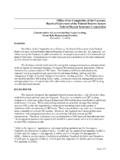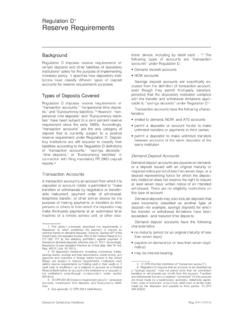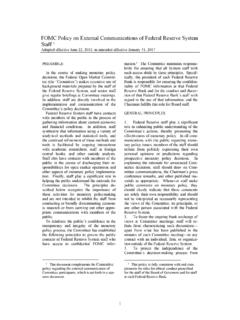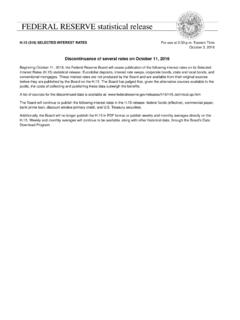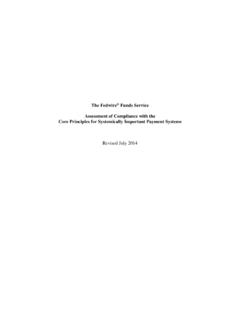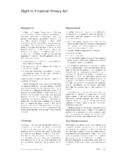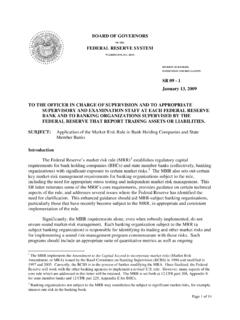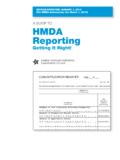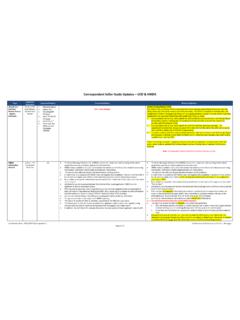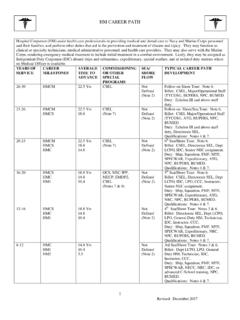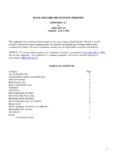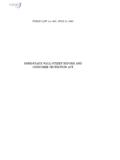Transcription of Home Mortgage Disclosure Act Examination Procedures
1 home Mortgage Disclosure Act Examination Procedures Background and Summary The home Mortgage Disclosure Act (HMDA) was enacted by the Congress in 1975 and is implemented by the Federal Reserve Board s Regulation C (12 CFR Part 203). The period of 1988 through 1992 saw substantial changes to HMDA. Especially significant were the amendments to the act resulting from the Financial Institutions Reform, Recovery, and Enforcement Act of 1989 (FIRREA). Coverage was expanded in the FIRREA amendments to include many independent nondepository Mortgage lenders, in addition to the previously covered banks, savings associations, and credit unions.
2 Coverage of independent Mortgage bankers was further expanded effective January 1, 1993, with the implementation of amendments contained in the Federal Deposit Insurance Corporation Improvement Act of 1991 (FDICIA). For a more detailed discussion of the history of HMDA see the FFIEC s web site at HMDA grew out of public concern over credit shortages in certain urban neighborhoods. The Congress believed that some financial institutions had contributed to the decline of some geographic areas by their failure to provide adequate home financing to qualified applicants on reasonable terms and conditions. Thus, one purpose of HMDA and Regulation C is to provide the public with information that will help show whether financial institutions are serving the housing credit needs of the neighborhoods and communities in which they are located.
3 A second purpose is to aid public officials in targeting public investments from the private sector to areas where they are needed. Finally, the FIRREA amendments of 1989 require the collection and Disclosure of data about applicant and borrower characteristics to assist in identifying possible discriminatory lending patterns and enforcing antidiscrimination statutes. As the name implies, HMDA is a Disclosure law that relies upon public scrutiny for its effectiveness. It does not prohibit any specific activity of lenders, and it does not establish a quota system of Mortgage loans to be made in any Metropolitan Statistical Area (MSA) or other geographic area as defined by the Office of Management and Budget.
4 Financial institutions must report data regarding loan originations, applications, and loan purchases, as well as requests under a preapproval program (as defined in (b)) if the preapproval request is denied or results in the origination of a home purchase loan. HMDA requires lenders to report the ethnicity, race, gender, and gross income of Mortgage applicants and borrowers. Lenders must also report information regarding the pricing of the loan and whether the loan is subject to the home Ownership and Equity Protection Act, 15 1639. Additionally, lenders must identify the type of purchaser for Mortgage loans that they sell. Some lenders have the option of indicating the reasons for their decisions to deny a loan application.
5 (Lenders regulated by the OCC or OTS must indicate the reasons for denial.) Regulation C requires institutions to report lending data to their supervisory agencies on a loan-by-loan and application-by-application basis by way of a register reporting format. The supervisory agencies, through the Federal Financial Institutions Examination Council (FFIEC), compile this information in the form of individual Disclosure statements for each institution, and in the form of aggregate reports for all covered institutions within each MSA. In addition, the FFIEC produces other aggregate reports that show lending patterns by median age of homes and by the central city or non-central city location of the property.
6 The public may obtain the individual disclosures and aggregate reports from the FFIEC or from central depositories located in each MSA. Individual Disclosure statements may also be obtained from financial institutions. home Mortgage Disclosure Act Examination Procedures 2 Applicability The regulation covers two categories of financial institutions. The first category is a depository institution, which the regulation defines as a bank, savings association, or a credit union that meets the following criteria: on the preceding December 31, had assets in excess of the annually published asset threshold; on the preceding December 31, had a home or branch office in an MSA; in the preceding calendar year, originated at least one first-lien home purchase loan (or a refinancing of such loan) on a one-to-four-family dwelling; and meets one of the following criteria: (1) the institution is federally insured or regulated.
7 (2) the Mortgage loan referred to is federally guaranteed, insured, or supplemented; or (3) the institution intended to sell the loan to Fannie Mae or Freddie Mac. The second category is a for-profit, nondepository Mortgage lending institution. A nondepository Mortgage lending institution is covered if: in the preceding calendar year, it originated home purchase loans (including refinancings of home purchase loans) that either: (1) equaled ten percent or more of its loan origination volume, measured in dollars; or (2) equaled $25 million or more; on the preceding December 31, had a home or branch office in an MSA1 either: (1) on the preceding December 31, had total assets of more than $10 million, counting the assets of any parent corporation; or (2) in the preceding calendar year, originated at least 100 home purchase loans, or refinancings of home purchase loans.
8 ; and For purposes of this discussion and the Examination Procedures , the term financial institution will signify both a depository and a nondepository institution. The definition of Mortgage lending institution applies to majority-owned Mortgage lending subsidiaries of depository institutions and, since 1990, to independent Mortgage companies. Mortgage lending subsidiaries of bank and savings and loan holding companies, as well as savings and loan service corporations, have been covered by HMDA since 1988. Mortgage lending subsidiaries are treated as distinct entities from their parent, and must file separate reports with their parent s supervisory agency.
9 The Board may exempt from Regulation C state-chartered or state-licensed financial institutions if they are covered by a substantially similar state law that contains adequate provision for enforcement by the state. As of January 1, 2009, no exemptions are in effect. Compilation of Loan Data For each calendar year, a financial institution must report data regarding its applications, originations, and purchases of home purchase loans, home improvement loans, and refinancings. Loans secured by real estate that are neither refinancings nor made for home purchase or home improvements are not reported. Data must 1 The institution may or may not have a physical presence in the MSA per section (c)(2) of Regulation C.
10 home Mortgage Disclosure Act Examination Procedures 3 also be given for loan applications that did not result in originations: applications approved by the institution but not accepted by the applicant, denied, withdrawn, or closed for incompleteness. Required reporting also includes certain denials of requests for preapproval of a home purchase loan under a program in which a lender issues a written commitment to lend to a creditworthy borrower up to a specific amount for a specific time. Loan Information For each application or loan, institutions are required to identify the purpose ( home purchase, home improvement, or refinancing), lien status, and whether the property relating to the loan or loan application is to be owner-occupied as a principal dwelling.

